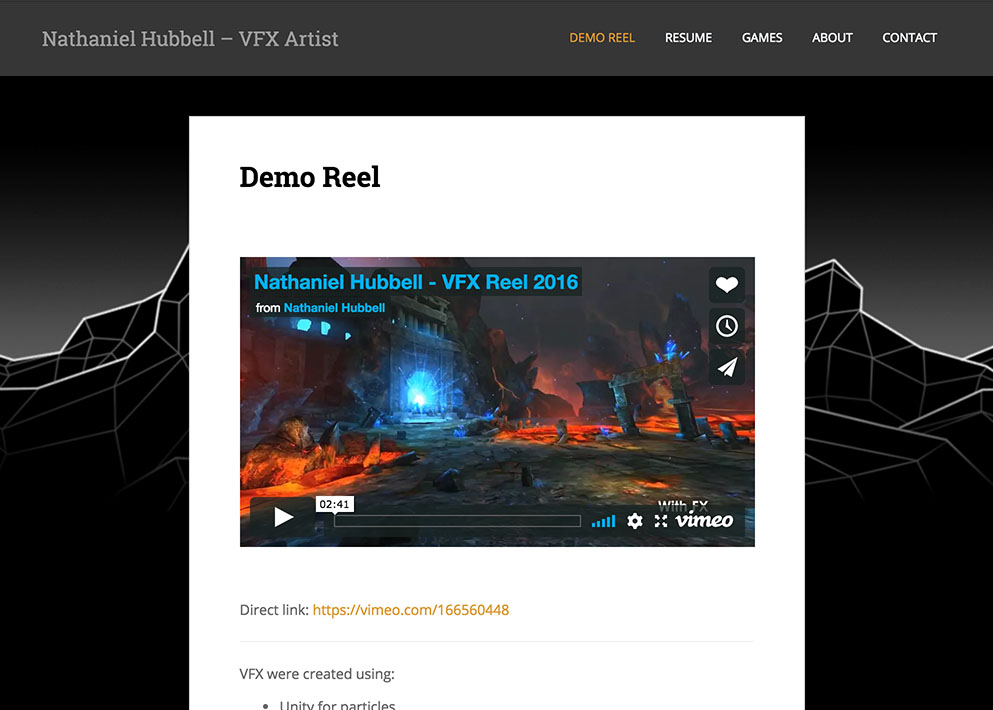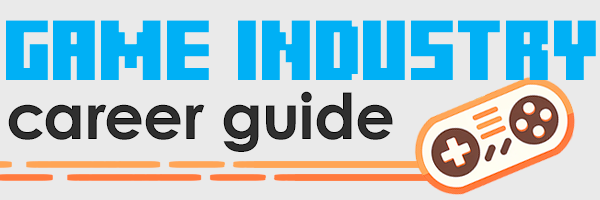Visual Effects Art Portfolio Example
 “I used to worry about making my portfolio perfect. As I’ve discovered, there’s no such thing.” That’s Nathaniel Hubbell, a professional visual effects (VFX) artist. And when it comes to career advice, it’s just the tip of the iceberg. Hubbell has been sailing the seas of professional art for over a decade, and readily shares his tips to help you navigate your own career successfully.
“I used to worry about making my portfolio perfect. As I’ve discovered, there’s no such thing.” That’s Nathaniel Hubbell, a professional visual effects (VFX) artist. And when it comes to career advice, it’s just the tip of the iceberg. Hubbell has been sailing the seas of professional art for over a decade, and readily shares his tips to help you navigate your own career successfully.

Visual Effects Art Portfolio Example
These days, an online portfolio is practically a requirement for any professional artist. Hubbell has been involved in hiring for several studios, and he says every applicant submitted their artwork as a web-based portfolio. Sharing art online is easy for the candidates, but it’s also easier for Hubbell to quickly determine who has the skills he’s looking for.
That’s why he recommends making a strong online portfolio, no matter what opportunity you’re pursuing. From applying to schools, to applying for internships or full-time jobs, start by building your online portfolio.
 Visual Effects Art Portfolio Example
Visual Effects Art Portfolio ExampleArtist: Nathaniel Hubbell
Job: Visual Effects (VFX) Artist
Portfolio: http://nathanielhubbell.com
Focus on your strengths
There’s an old rule that Hubbell says serves him well: “If in doubt, leave it out.” If a piece of work doesn’t present your skills at their best, it doesn’t belong in your VFX art portfolio.
For example, let’s say you’re an excellent visual effects artist and you’ve recently started working on your life-drawing skills. Unless you’re creating strong pieces that clearly showcase a talent, Hubbell recommends that you keep them in your sketchbook — not your portfolio website. Instead, he says, use your resume to mention any secondary skills you happen to be working on.

Include the right pieces
Assuming you take Hubbell’s advice to only show your strongest work, how do you decide which pieces to include? It’s hard to know for sure. Hubbell says there’s no formula for determining which examples of your art are the strongest. You just need to build enough familiarity with your field to get a sense for which pieces look best.
But if you don’t yet have that level of familiarity, it’s helpful to get feedback from someone whose expertise you can trust. Hubbell says, “Don’t be afraid to ask a mentor, instructor, or trusted colleague for critiques on your portfolio.” Getting advice from others is especially important for students just starting school, or recent graduates just starting the job hunt. And of course, it’s always educational to study the portfolio examples provided by successful artists.
Practice your art independently
If you’re a professional artist, your best work may fall under a nondisclosure agreement (NDA) for years at a time. That means you can’t show it to anybody, which makes it hard to keep your portfolio up to date. In that case, Hubbell suggests doing independent side projects as an excellent way to exhibit your new skills while your pro work is under NDA.
What’s more, doing independent work may be your best strategy to fill in the skills gaps in your existing portfolio. “Apart from creative expression,” Hubbell says, “one advantage of doing personal art is that you can tailor it to your portfolio, bolstering any areas you feel are lacking.” But if you do include independent art in your online portfolio, remember to make sure it’s at least as polished as the professional work you’ve included.

Don’t sweat perfection
Hubbell used to worry about making his portfolio “perfect.” But over the years, he’s discovered that perfect isn’t necessary. In fact, it isn’t even achievable. That’s because different art managers are looking to fill different needs, so there’s no ideal portfolio that can impress every potential employer, client, or school. Hubbell says, “One person might think your work is exactly what they’re looking for, while another might reject it out of hand.”
That situation has happened to Hubbell more than once in his own career. So while there may be plenty of work ahead to optimize your portfolio, don’t be too hard on yourself. Even the best portfolios won’t amaze everybody all the time.
Your portfolio is just the beginning
While having a strong portfolio is an important part of getting accepted into a school or landing a job, your personality and communication skills are also important. Hubbell says, “Remember that you’re not just trying to impress the hiring manager with how brilliant you are.” Most companies are searching for candidates who will also work well with their team.
That’s why you should strive to make all of your interactions clear and respectful, not just your portfolio. Remember to be professional and courteous in your cover letter, emails, causal conversations, and interviews. “If you make it easy and comfortable for the hiring manager to communicate with you,” says Hubbell, “that will go a long way toward making a positive impression.”
And that positive impression can make all the difference. So set your career on the right course: Focus on your strengths, include the right pieces in your portfolio, and make a positive impression, and the next big opportunity could be yours.
All images via Nathaniel Hubbell, nathanielhubbell.com
Read my new book!
Making games for a living is an incredibly rewarding career, but it’s hard to break in unless you have insider knowledge. This book levels the playing field.


Leave a Reply